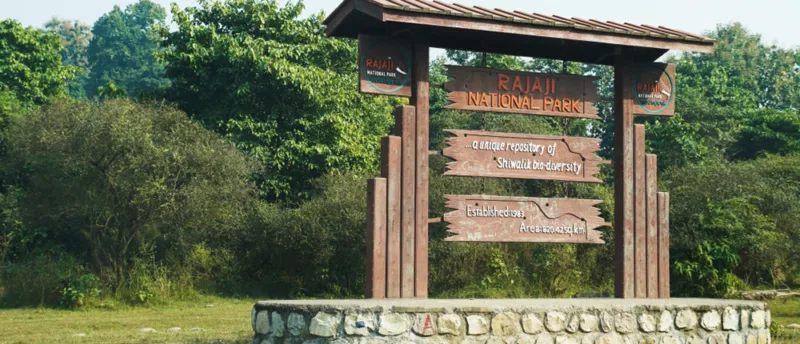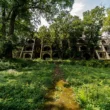Rajaji National Park, nestled in the lap of the Himalayas, is a jewel of India’s wildlife heritage. Named after the renowned freedom fighter, C. Rajagopalachari, this national park is a sanctuary for numerous endangered species and a sanctuary for nature enthusiasts.
Location and History
Established in 1983, Rajaji National Park spans over 820 square kilometers across the states of Uttarakhand and Uttar Pradesh in northern India. It was created by amalgamating three sanctuaries – Rajaji, Motichur, and Chilla. The park’s strategic location at the foothills of the Shivalik range makes it a crucial corridor for wildlife movement between the Himalayan foothills and the plains.
Biodiversity
Flora
Rajaji National Park boasts a rich tapestry of flora, comprising diverse vegetation ranging from dense forests to open grasslands. Sal forests dominate the landscape along with mixed deciduous forests, bamboo groves, and riverine vegetation.
Fauna
The park is a haven for wildlife enthusiasts, offering glimpses of various species including elephants, tigers, leopards, deer, and bears. It is also home to a myriad of bird species, making it a paradise for birdwatchers.
Similar Article – Parmarth Niketan
Geographical Features
Rivers
Traversed by the Ganges and its tributaries, the park’s landscape is sculpted by the flowing waters, creating an intricate network of rivers, streams, and waterfalls. These water bodies not only sustain the diverse ecosystem but also provide a picturesque setting for visitors.
Terrain
The terrain of Rajaji Park varies from rugged hills to flat plains, offering diverse habitats for its inhabitants. The park’s topography includes valleys, ridges, and ravines, adding to its scenic beauty.
Wildlife Conservation Efforts
Despite facing numerous challenges, Rajaji National Park is at the forefront of wildlife conservation efforts in India. The park authorities are actively involved in protecting endangered species and their habitats through various initiatives.
Threatened Species
Rajaji National Park is home to several endangered species such as the Bengal tiger, Asian elephant, and gharial. Conservation efforts focus on safeguarding these species from threats like habitat loss and poaching.
Conservation Programs
The park implements various conservation programs in collaboration with governmental and non-governmental organizations to monitor wildlife populations, mitigate human-wildlife conflicts, and preserve critical habitats.
Visitor Information
Entry Points
Rajaji Park offers multiple entry points for visitors, including Ramgarh, Mohand, Ranipur, and Motichur. Each entry point provides access to different parts of the park, allowing visitors to explore its diverse landscapes.
Safari Options
Safari experiences are the highlight of a visit to Rajaji National Park, offering tourists a chance to spot elusive wildlife in their natural habitat. Jeep safaris, elephant safaris, and trekking expeditions are popular choices among visitors.
Activities for Tourists
Safari Experiences
Embarking on a safari adventure through the wilderness of Rajaji National Park is an exhilarating experience. The park’s knowledgeable guides ensure memorable encounters with the resident wildlife while adhering to responsible tourism practices.
Bird Watching
With over 400 bird species recorded within its boundaries, Rajaji Park is a haven for birdwatchers. From colorful kingfishers to majestic birds of prey, the park’s avian diversity never fails to mesmerize visitors.
Accommodation Options
Inside the Park
For those seeking an immersive experience, the park offers forest rest houses and campsites within its premises. These accommodations provide a unique opportunity to connect with nature while enjoying modern amenities.
Nearby Lodging
Alternatively, visitors can opt for lodging options in the nearby towns of Haridwar, Rishikesh, and Dehradun, which offer a range of hotels, resorts, and guesthouses to suit every budget and preference.
Best Time to Visit
The best time to visit Rajaji National Park is during the winter months from November to March when the weather is pleasant, and wildlife sightings are more frequent. However, the park remains open throughout the year, each season offering a unique experience to visitors.
Challenges and Threats
Despite its protected status, Rajaji National Park faces several challenges that threaten its biodiversity and ecological balance. Human-wildlife conflict, habitat fragmentation, and poaching are among the key issues that require concerted efforts to address.
Community Involvement
Recognizing the importance of community participation in conservation, the park authorities engage with local communities to raise awareness about wildlife conservation, promote sustainable livelihoods, and foster a sense of stewardship towards the environment.
Research and Education
Rajaji National Park serves as a living laboratory for researchers and scientists studying various aspects of ecology, biodiversity, and conservation. Educational programs and workshops are conducted to disseminate knowledge and foster a culture of conservation among the youth.
Impact of Tourism
While tourism brings economic benefits to the region, it also poses challenges such as habitat disturbance and increased pressure on natural resources. Sustainable tourism practices, including responsible behavior and eco-friendly initiatives, are essential to minimize the negative impact on the park’s fragile ecosystem.
Sustainable Practices
Efforts are underway to promote sustainable practices within Rajaji Park, including waste management, energy conservation, and eco-tourism initiatives. By adopting a holistic approach to conservation, the park aims to ensure the long-term survival of its precious wildlife and habitats.
Conclusion
Rajaji National Park stands as a testament to India’s commitment to wildlife conservation and sustainable development. With its breathtaking landscapes, rich biodiversity, and tireless conservation efforts, the park offers a glimpse into the wonders of nature and the importance of preserving it for future generations to cherish.
FAQs
- Is Rajaji National Park safe for tourists?
- Yes, Rajaji National Park is safe for tourists, provided they adhere to the guidelines and instructions provided by the park authorities.
- What are the safari options available at Rajaji National Park?
- Visitors can choose from jeep safaris, elephant safaris, and trekking expeditions to explore the park’s wilderness and spot its resident wildlife.
- When is the best time to visit Rajaji National Park?
- The best time to visit Rajaji National Park is during the winter months from November to March when the weather is pleasant, and wildlife sightings are more frequent. However, the park remains open throughout the year, each season offering a unique experience to visitors.
- What types of accommodation are available in and around Rajaji Park?
- Accommodation options within the park include forest rest houses and campsites, providing visitors with a chance to stay amidst nature. Additionally, there are various hotels, resorts, and guesthouses available in nearby towns like Haridwar, Rishikesh, and Dehradun to suit different preferences and budgets.
- Are there any specific guidelines visitors should follow during their stay at Rajaji National Park?
- Yes, visitors are required to follow certain guidelines to ensure their safety as well as the preservation of the park’s ecosystem. These guidelines include refraining from littering, maintaining a safe distance from wildlife, and obeying the instructions of park authorities and guides during safaris.
- What are the major conservation challenges faced by Rajaji National Park?
- Rajaji National Park faces challenges such as human-wildlife conflict, habitat degradation, and poaching, which threaten the survival of its precious biodiversity. Conservation efforts are underway to address these challenges through community involvement, research initiatives, and sustainable practices.
- How can tourists contribute to the conservation of Rajaji National Park?
- Tourists can contribute to the conservation of Rajaji National Park by practicing responsible tourism, supporting eco-friendly initiatives, and spreading awareness about the importance of wildlife conservation. Additionally, participating in organized clean-up drives and adhering to ethical wildlife viewing practices can help minimize the negative impact of tourism on the park’s ecosystem.









